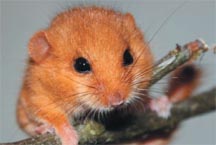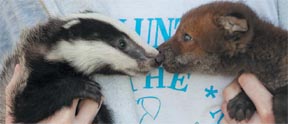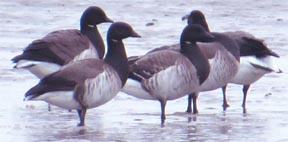|
Wildlife
Newsletter for the Township of Dalkey March 2015 - Michael Ryan |
 Dormouse – Photo: Kildare Animal Foundation |
I
had heard about a young swan which had a non-fatal collision with a
train near Booterstown last year and had then been rescued off the tracks
by the Booterstown Dart stationmaster. He had kept the cygnet safe and
comfortable in a back room till it was taken to the animal hospital
in UCD where it was kept overnight before being transferred the following
day to the Kildare Animal Foundation, a charity which takes in, treats
and rehomes domestic animals as well as caring for a increasing variety
of wild animals and birds.I wasn’t able to get in touch with the
stationmaster and presumed the bird probably hadn’t survived.
I eventually got in touch with the Kildare Animal Foundation and was
pleasantly surprised to hear that the swan was in fact still alive,
in very good health and they hoped that after a period of rehabilitation
they would be able to re-release it back into the wild. |
|
|
The Kildare Animal Foundation website itself is fascinating.
When a Dormouse, a mammal previously unknown in Ireland before this
century, was found in the wild (actually asleep in a treehouse, the
person who found it thought it was a baby squirrel) in a Kildare garden
in 2010 it was taken to the Kildare Animal Foundation. Dormice are
found in Britain but are a threatened species there and very rare
but, like most Irish people, the nearest I’d have got to a dormouse
would be reading about the one who slept through most of the tea party
in Alice in Wonderland. They’re beautiful little creatures with
golden brown fur, big eyes and, unlike other mice species a very fluffy
tail. The tail is probably an asset to keeping it warm as they do
hibernate and it’s estimated they can spend up to three quarters
of their life asleep. |
||

Badger and Fox – Photo: Kildare Animal Foundation |
I
eventually got in touch with the stationmaster at Booterstown who had
rescued the swan and he told me that their station and Grand Canal Dock
Dart station regularly get swans in trouble, the birds often standing
immobile on the tracks (it’s possible some of them may have collided
with overhead wires), and they have become quite adept at catching them,
throwing a big coat over them and wearing gloves to avoid pecks and
then either returning them to water or else getting help for them if
injured. The Booterstown stationmaster, Peter Ridgeway, told me that
last year there was a swan leading a family of tiny cygnets outside
the station on the car park side. The swan began walking, with little
family in tow, towards the main road and possible calamity but Peter
caught up with them, headed off the swan and drove them back into the
safety of the marsh. |
|
If
you do encounter a wild animal or bird in trouble and you can’t
get immediate professional help the website of Irish Wildlife Matters
is invaluable for giving instant information on how to handle or catch
injured animals, how to assess their injuries and how best to keep them
or transport them if further treatment is needed. It also has a list
of contacts around the country some of whom specialise in treating specific
creatures such as hedgehogs or birds of prey and they will either give
appropriate advice or actually take in the injured animal or bird. –
http://www.irishwildlifematters.ie |
| If
asked what species of goose has the longest migration from breeding
ground to wintering area you might think that it’s a species like
the bar-headed goose which flies from its breeding grounds in Mongolia
over the Himalayan Mountains to winter in southern India. Although they
fly high there is another species of goose that travels much farther.
In fact the goose with the longest migration distance is the light bellied
Brent, the same small goose you can still see now often gathered in
numbers in Booterstown Marsh, feeding on the rugby pitch at Blackrock
College, swimming around Scotsman’s Bay, feeding on Dalkey Island
or flying up the coast at dusk after feeding in Wicklow, in fact all
along the east coast in winter. |
 Brent Geese at Booterstown – Photo: M. Ryan |
| They
nest in the eastern Queen Elizabeth Islands of Arctic Canada and migrate
to Ireland via Greenland and Iceland and some of the birds who will
be leaving our shores in March or April will be nesting in June just
500 miles south of the North Pole. Before their breeding grounds turn
to sub-zero temperatures and 24 hours of darkness the majority of the
world’s population of light-bellied Brent will move south through
Greenland and Iceland to spend winter in Ireland making them one of
our most important wintering birds. The geese’s favourite food
is a type of marine plant called eelgrass or Zostera, which grows in
estuaries and around the coast but this will all be consumed by late
winter and after this food source has been exhausted they move on to
pasture and other green areas, often football pitches and parks. While
in Dublin Bay they might be threatened by foxes and chased by dogs but
when they’re sitting on their nests they’ll be in danger
from Arctic foxes and wolves. The word ‘brent’ is derived
from the Norse word ‘brand’, meaning burnt. The geese were
given this name because of their colour - like charcoal. Before April
is over these birds will be on their way north again. |